Using Conditional Formula
The conditional formula set up in Zoho Forms allows you to configure your form to perform certain calculations based on your respondents' answers. These predefined conditions are simple to set up and they will tailor your form to your user's needs. With Conditional Formula you can perform data-driven calculations, and provide customized auto-filled payments, which means the form will provide customers with a unique payment amount with the calculated mathematical output, saving you the burden of calculating for each case.
Overview
A condition refers to a setup which will include the following 3 things:
- The field(s) to be checked.
- The condition to be satisfied (is, is not, is empty, etc).
- The mathematical calculation to be performed.

This is similar to the If and Else conditions that you use in Excel. When the condition is found to be true, it executes a certain mathematical calculation and when found to be false, it moves on to the next condition. 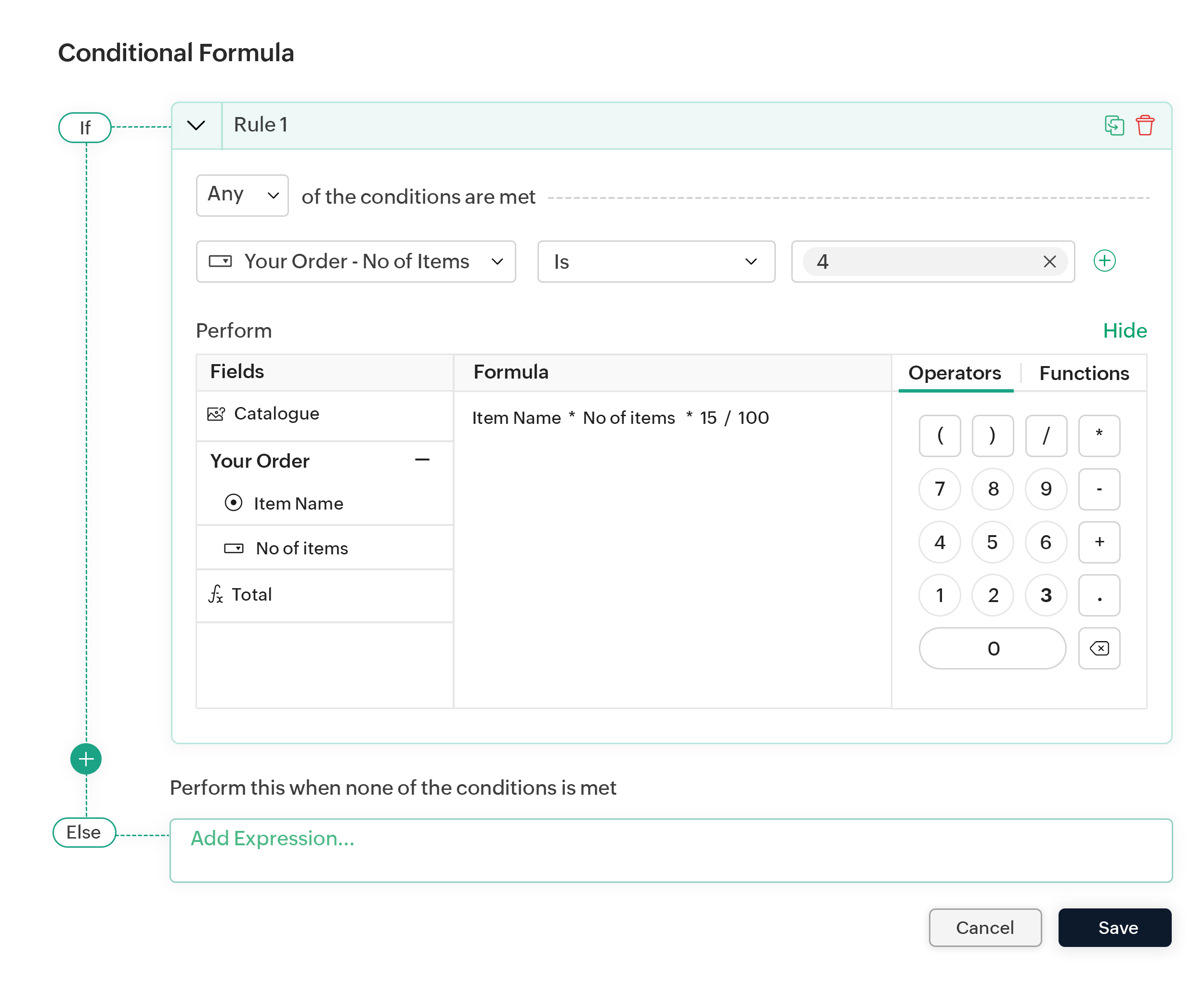
You can even set
multiple conditions, where the fields can be checked for multiple answers to perform a distinct calculations.
To understand this better, here are a few scenarios:
- Waive off a 50% discount on the total purchases on more than five shirts.
- Calculate taxes based on the annual income range.
- Offer a discount of 20$ upon the coupon code of DISCOUNT20SPRING.
- Offer a bulk discount of 100$ if the total purchase amount is above a threshold value.
Check out how to configure a few of these examples.
Setup
To set up conditional formula,
- Add a Formula field to your form from the Advanced Fields.
- In the pop-up, click
 .
. - In the Conditional Formula pop-up, set up the necessary logic.
- Choose All or Any, from the dropdown.
- To add more conditions, click the
 icon.
icon. - Under Perform when none of the conditions is met, set up the formula that will be performed when none of the conditions is found to be true. This is also referred to as a default expression.
- To delete a condition, click the
 icon.
icon.
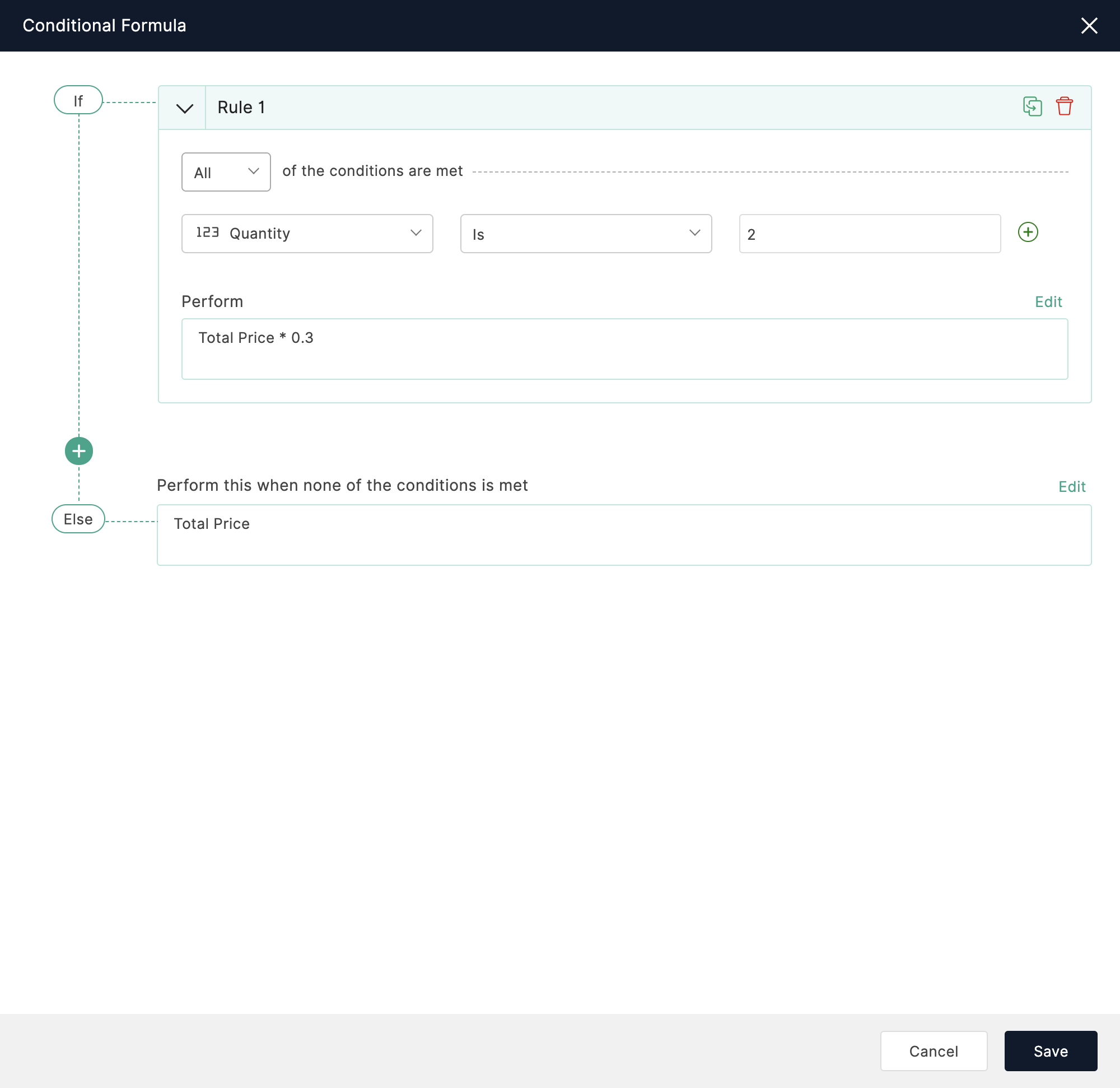
Adding multiple conditions
You can add more than one condition to perform calculations. This will be useful when you want to check the field for multiple answers and perform distinct mathematical calculations based on it. For example, in a scenario where you are expecting numerous coupon codes to waive off appropriate discounts during your spring sale, you can process the coupon codes in simpler steps. The payment will differ for each customer based on the type of coupon they own.
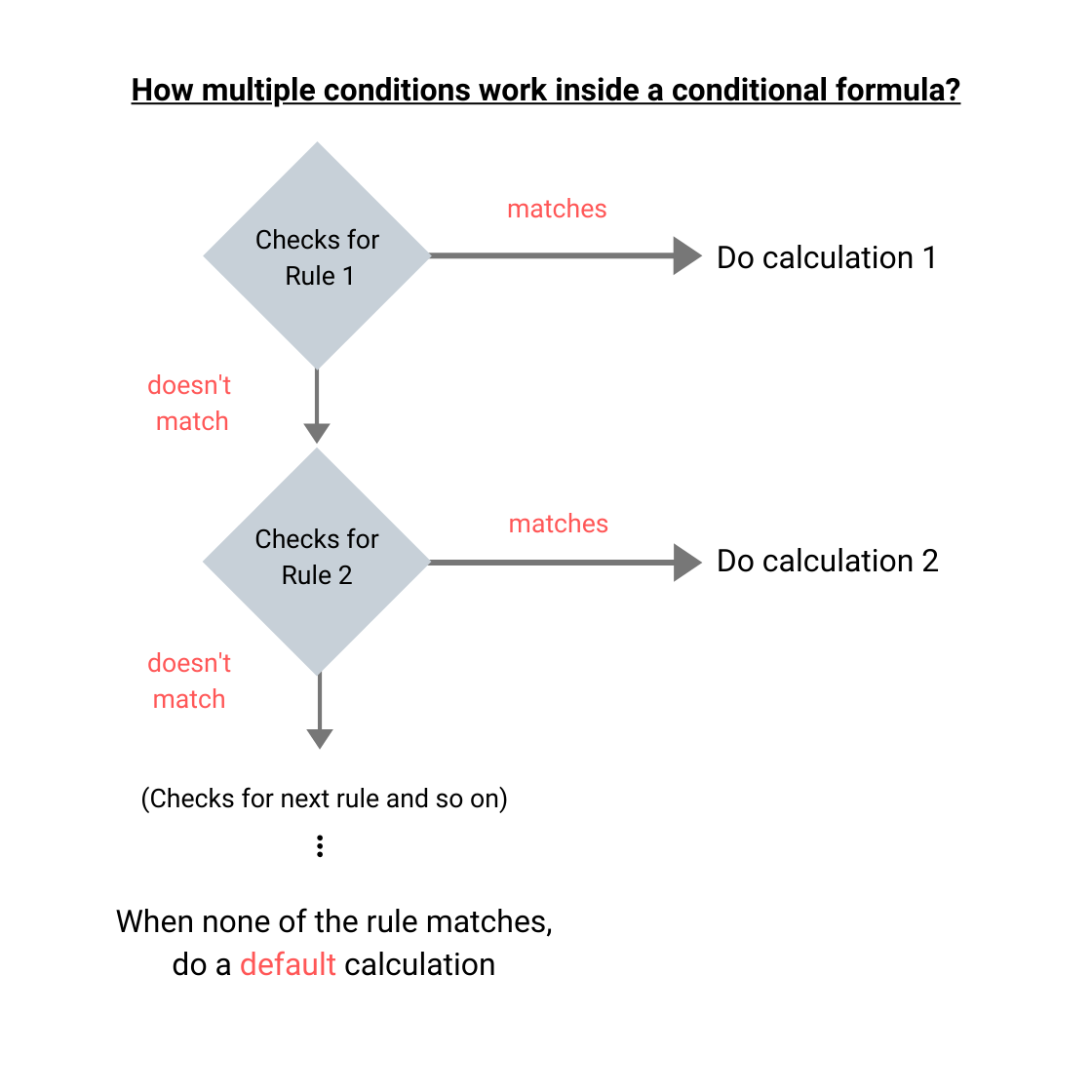

Note:
- Free Plan: You can add up to 10 rules per form, with each rule supporting up to 10 conditions.
- Paid Plan: You can add up to 30 rules per form, with each rule supporting up to 15 conditions.
Examples
Scenario 1:
Processing the coupon code DISCOUNT20 to waive off 20% on the total price of the purchase.
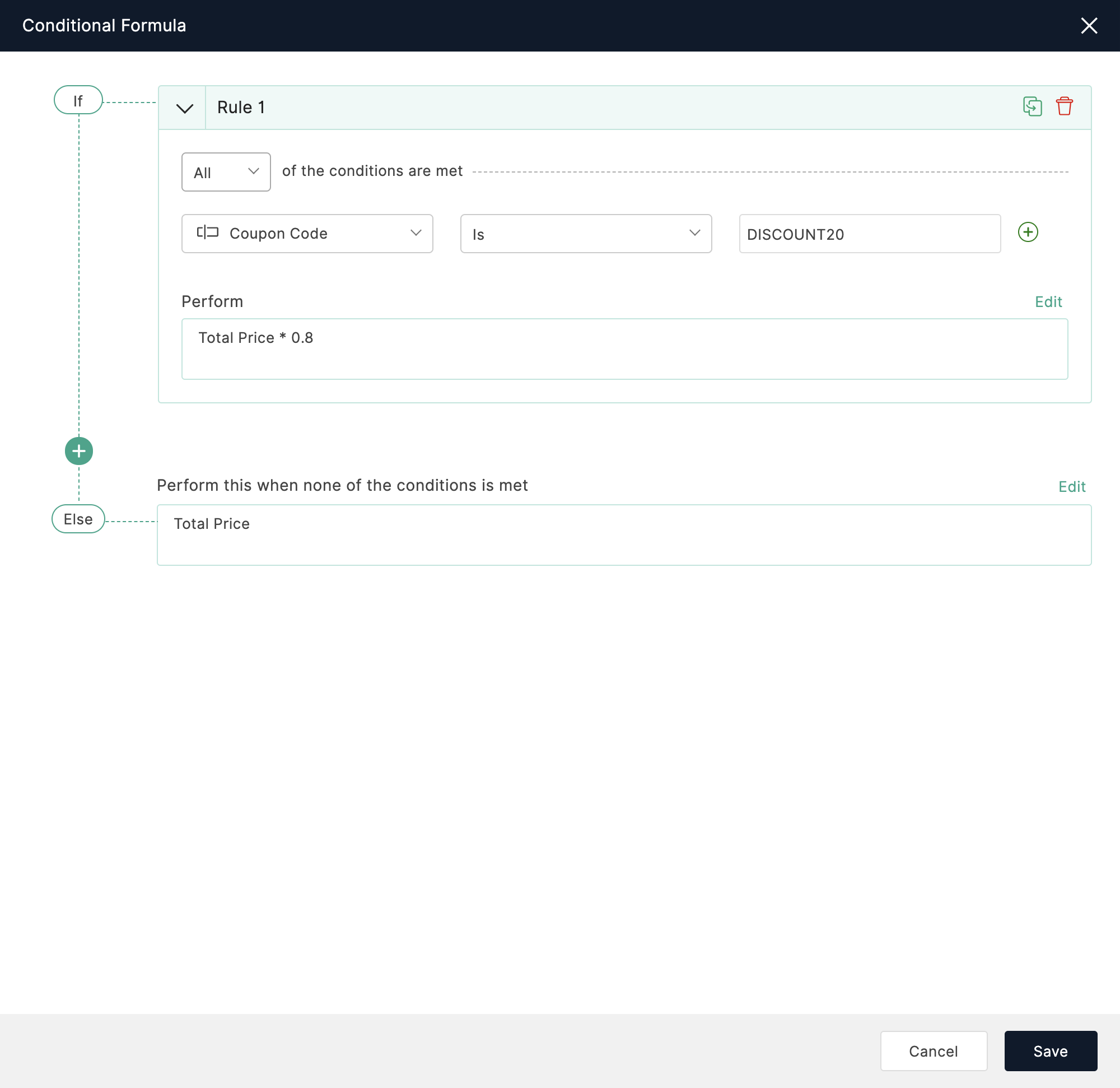
Scenario 2: Waiving off 100$ on the total price of the shirts upon the orders of 5 or more.
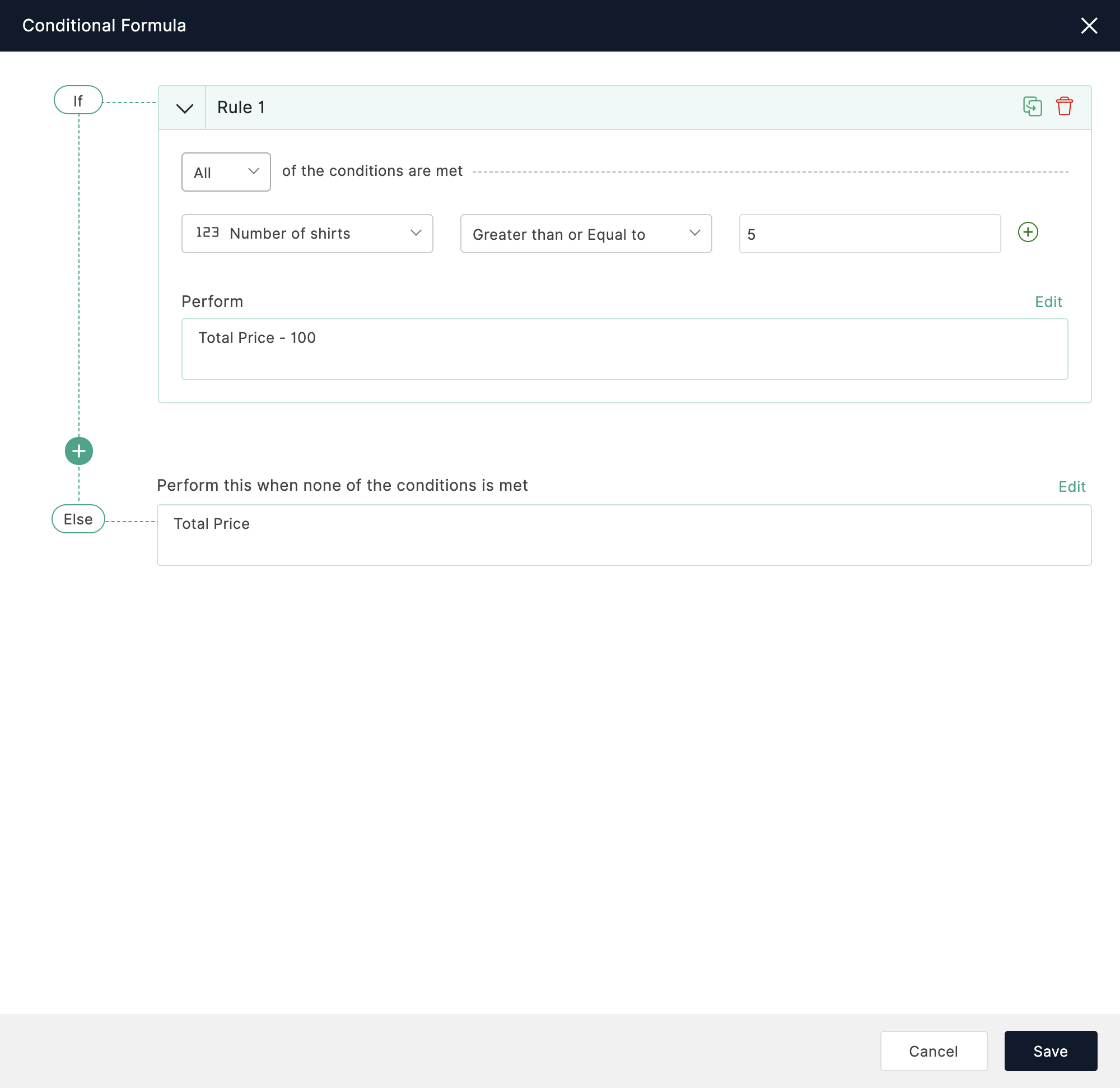
Scenario 3:
Deciding the tax based on the annual income range of the employee.

Supported Operators
Text and field comparison
- Is: Checks if the selected field is equal to the set value
- Is Not: Checks if the selected field is not equal to the set value
- Is Empty: Checks if the selected field is empty
- Is Not Empty: Checks if the selected field is not empty
- Contains: Checks if the selected field contains a value in the condition
- Not Contains: Checks if the selected field does not contain a value in the condition
- Contains Any Of: Checks if a field contains any of the selected choices
- Contains All Of: Checks if a field contains all of the selected choices
- Contains None Of: Checks if a field contains none of the selected choices
- Starts With: Checks if the selected field starts with the given value
- Ends With: Checks if the selected field ends with the given value
Choice and selection
- Other Choice Is Not Empty: Checks if a value is entered in the Other choice
- Is Any Of: Checks if any of the choices chosen in the condition match
- Is None Of: Checks if none of the choices chosen in the condition match
Numeric Comparison
- Less Than: Checks if a number is less than a given value
- Greater Than: Checks if a number is greater than a given value
- Less Than or Equal To: Checks if a number is less than or equal to a given value
- Greater Than or Equal To: Checks if a number is greater than or equal to a given value
- Between: Checks if a number/date is between 2 given values
- Not Between: Checks if a number/date is not between 2 given values
Date and Time Comparison
Day of the week
- Day Is: Checks if a date falls on the selected day of the week
- Day Is Not: Checks if a date does not fall on the selected day of the week
- Is Any of Selected Days: Checks if a date falls on any of the selected days of the week
- Is None of Selected Days: Checks if a date does not fall on any of the selected days of the week
Relative Days
- Is Previous Day: Checks if a date falls on the previous day
- Is Current Day: Checks if a date falls on the current day
- Is Next Day: Checks if a date falls on the next day
- Is Before [x] Day(s): Checks if a date falls 'x' number of days before the current date
- Is After [x] Day(s): Checks if a date falls 'x' number of days after the current date
Week
- Is Previous Week: Checks if a date falls in the previous week
- Is Current Week: Checks if a date falls in the current week
- Is Next Week: Checks if a date falls in the coming week
Month
- Is Previous Month: Checks if a date falls in the last month
- Is Current Month: Checks if a date falls in the current month
- Is Next Month: Checks if a date falls in the next month
- Month Is: Checks if a date falls in selected month of the year
- Is Any of Selected Months: Checks if date falls in any of the selected months of the year
- Is None of Selected Months: Checks if date does not fall in any of the selected months of the year
Year
- Is Previous Year: Checks if a date falls in the last year
- Is Current Year: Checks if a date falls in the current year
- Is Next Year: Checks if a date falls in the coming year
- Year Is: Checks if a date falls in selected year
Past and Future
- Is in the Past: Checks if a date falls in the past
- Is in the Future: Checks if a date falls in future
Time
- Time Is Before: Checks if the time falls before the specified time.
- Time Is After: Checks if the time occurs after the specified time.
- Time Is Between: Checks if the time falls between two specified times.
- Time Is Not Between: Checks if the time is outside the specified time range.
- Time Is: Checks if the time matches the specified time.
- Time Is Not: Checks if the time does not match the specified time.
Time on previous day
- Is Previous Day Before: Checks if the time on the previous day is earlier than a specified time.
- Is Previous Day After: Checks if the time on the previous day is later than a specified time.
- Is Previous Day Between: Checks if the time on the previous day is within a specified time range.
- Is Previous Day Not Between: Checks if the time on the previous day is not within a specified time range.
- Is Previous Day At: Checks if the time on the previous day matches a specified time.
- Is Previous Day Not At: Checks if the time on the previous day does not match a specified time.
Time on current day
- Is Current Day Before: Checks if the time on the current day is earlier than a specified time range.
- Is Current Day After: Checks if the time on the current day is later than a specified time range.
- Is Current Day Between: Checks if the time on the current day is between a specified time range.
- Is Current Day Not Between: Checks if the time on the current day is outside a specified time range.
- Is Current Day At: Checks if the time on the current day matches a specified time.
- Is Current Day Not At: Checks if the time on the current day does not match a specified time.
Time on next day
- Is Next Day Before: Checks if the time on the next day is earlier than a specified time.
- Is Next Day After: Checks if the time on the next day is later than a specified time.
- Is Next Day Between: Checks if the time on the next day is within a specified time range.
- Is Next Day Not Between: Checks if the time on the next day is outside a specified time range.
- Is Next Day At: Checks if the time on the next day matches a specified time.
- Is Next Day Not At: Checks if the time on the next day does not match a specified time.
Boolean Comparison
- True: Checks if logical TRUE value is returned
- False: Checks if logical FALSE value is returned
The following table lists the operators that can be used with the corresponding field types to form a rule criteria in the If section:
Field Types | Supported Operators | |
| Name |
| |
Name - First Name - Last |
| |
Single Line Multi Line Phone |
| |
| Number Decimal Currency Rating Formula |
| |
Website |
| |
| Address |
| |
Address - Street Address Address - Address Line 2 Address - City Address - State/Region/Province Address - Postal/Zip Code |
| |
Address - Country |
| |
| Email Website |
| |
Date |
| |
Date-Time |
| |
| Time |
| |
| Decision Box Terms and Conditions |
| |
| Radio Dropdown |
| |
| Multiple Choice Checkbox Image Choices |
| |
| Matrix Choice |
| |
| Slider |
| |
| Signature |
|
Refer to the FAQs on performing calculations using conditional formula.
Zoho CRM Training Programs
Learn how to use the best tools for sales force automation and better customer engagement from Zoho's implementation specialists.
Zoho DataPrep Personalized Demo
If you'd like a personalized walk-through of our data preparation tool, please request a demo and we'll be happy to show you how to get the best out of Zoho DataPrep.
New to Zoho Writer?
You are currently viewing the help pages of Qntrl’s earlier version. Click here to view our latest version—Qntrl 3.0's help articles.
Zoho Sheet Resources
Zoho Forms Resources
New to Zoho Sign?
Zoho Sign Resources
New to Zoho TeamInbox?
Zoho TeamInbox Resources
New to Zoho ZeptoMail?
New to Zoho Workerly?
New to Zoho Recruit?
New to Zoho CRM?
New to Zoho Projects?
New to Zoho Sprints?
New to Zoho Assist?
New to Bigin?
Related Articles
Field Rules
Overview Using the Field Rules, you can choose to show or hide certain form fields to your respondents or set certain fields as mandatory to fill in based on their previous responses on the form. This way, you can let your respondents see only the ...Page Rules
Overview You can use Page Rules to direct form respondents to a specific page in a multi-page form based on their input. Using multi-page forms with Page Rules is a smart way to ensure that your respondents see only the pages relevant to them while ...Rules in Form Approvals
With conditional rules in form approvals, you can define the conditions and actions to be performed if the conditions are met on the final approval or denial. You can configure rules with a combination of AND/OR connectors between multiple condition ...Form Rules
With the Form Rules, you can choose to trigger different actions upon form submission if the defined conditions are satisfied. You can automatically trigger emails, assign tasks, decide on the Thank You page to be displayed or redirect the ...Using Rules to Automatically Assign Tasks
You can configure rules to automatically assign tasks to your users as soon as a form entry comes in. The records will be assigned as tasks if they satisfy the defined conditions. To do so, In your form builder, navigate to Rules tab > Form Rules and ...
New to Zoho LandingPage?
Zoho LandingPage Resources















